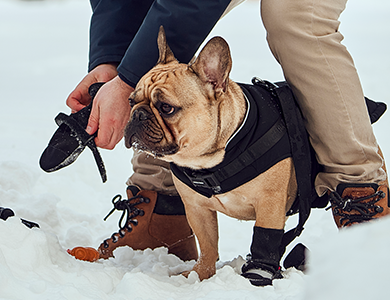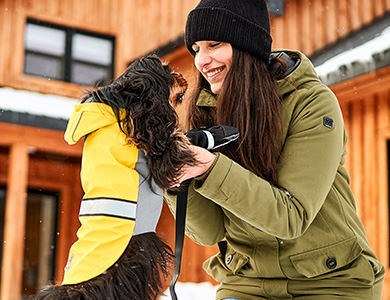Wondering why many people put their dogs in winter clothes? For some breeds, winter clothing is not a question of fashion, but of comfort.

Why should you winterize your dog?
Clothing for dogs is, nowadays, more and more for both aesthetic and practical purposes. Some breeds find it harder to cope with the cold (greyhound, chihuahua, Yorkshire) because they are often shorthaired or their fur does not adapt to the seasons. Puppies and older dogs are also more vulnerable to freezing temperatures. We recommend getting your dog into winter clothes so you can continue to walk them every day, even when it’s cold.
Your pooch might get chilly, but taking shorter and more frequent walks will help keep them in shape and prevent them from causing trouble at home due to boredom. It will be important to choose clothes that fit them properly so as not to hinder them when they are walking or need to relieve themselves.
How to choose a coat for your dog
You'll find wide variety of coats on the market. However, before opting for a colour or pattern you think is cute, remember that a coat should primarily be warm enough according to your dog's age, size and type of fur. The fabric and its thickness will also be important for your dog's comfort.
Some coats will only protect your dog’s body while others come down to the paws. Some might even have hoods! However, hoodless coats are preferable because they don’t obscure vision or cause unnecessary stress.
Also read: How to accurately measure your dog for a perfect fit
How to protect your dog's paws
Snow, ice, water, cold temperatures and salt can wreak havoc on your dog’s paw pads. We recommend dog boots to protect your dog's paws from frostbite and cuts caused by pads that are too dry and damaged. Here are some suggestions:

Muttluks
- A Canadian product, perfect for our cold winters.
- Solid and comfortable footwear, suitable for walking and even running. Superb quality to last multiple winters.
Pawz
- For dogs prone to losing their boots.
- They come in packs of 12 instead of 4, so you don't need to buy extra boots if you only lose one or two occasionally.
- Don't forget to make your dog wear a little sock in it, as moisture can build up and lead to dermatitis.
Protective balm
- For dogs who hate wearing boots.
- Provides a minimum of protection against salt and ice.
How to get your dog used to putting on clothes
The following technique also works for coats, harnesses, etc.:
- Take out a single boot and place it on the ground. Scatter treats all around it and allow your dog to approach.
- When your dog approaches the boot without difficulty, pick it up and reward your dog as soon as they come to sniff or touch it.
- Next, touch one of their paws with the boot (preferably the one where your dog feels the least discomfort). Reward them if they stay calm.
- Gradually continue until you can place the boot on the paw.
- During your walks, have your dog wear only one boot, and add a new boot one at a time.
The exercises should last 2-3 minutes and be repeated 2 to 3 times a day. Don't move to the next step if your dog isn't 100% comfortable.
With the cold weather approaching, there's no reason to stay cooped up indoors. Put on your warm clothes, dress up your dog, and go for a stroll outside—it'll do you both good!
Also read : How to keep your dog active indoors when it's cold outside?










